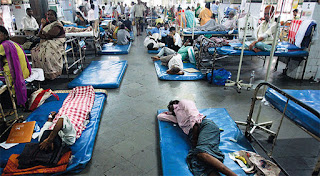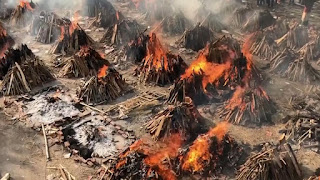COLLAPSING OF HEALTH INFRASTRUCTURE IN INDIA
The second wave of the Covid-19 pandemic that is ravaging India’s cities is likely to cause even greater devastation with infections spreading to smaller towns and villages. Health infrastructure in a rural and small town in India is far weaker than that in cities. Unable to access medical treatment, many Covid-19 patients in rural India are dying. The daily caseload during the second wave has touched unprecedented levels. On 1st May, the country reported more than 4 lakhs new infections in the preceding 24 hours, bringing the country’s total tally of Covid-19 cases to over 26 million. Today the health infrastructure of India is in pathetic condition. It needs radical reforms to deal with new emerging challenges. The role of private players is continuously increasing in the healthcare sector, but simultaneously healthcare facilities are getting costly, and becoming non-accessible to the poor. Government hospitals are facing the problem of a lack of resources and infrastructure; there is an inadequate number of beds, rooms, and medicines. On the part of the government, there is a lack of monitoring of the funds and resources, which were devoted to the improvement of the health sector. The experts have suggested a model healthcare plan which devolves around preparing a long-term strategy for qualitative as well as quantitative improvements in our healthcare infrastructure by focusing on workforce capacity and competency, information and data system, organizational capacity, etc.

CAUSES FOR INDIAN HEALTH SECTOR COLLAPSE
India’s health care system and other essential services are close to collapse as a second corona wave that started in mid-march tears through the country with devastating speed. Due to lockdown at several places, thousands of migrants have been seen heading towards railway stations and bus stops in cities such as Mumbai and Delhi. Yet the central government has maintained that no reverse migration is taking place. The second wave, which has surpassed the first is a situation created by complacency, say, experts, pointing to the government’s relaxing measures, and a false sense of security from the public weeks before cases began climbing again. The federal health minister declared that India was “in the endgame” of the pandemic. Despite warnings of Covid risks, sports matches resumed, weddings were held and movie cinemas reopened. In April, one of the biggest Pilgrimages on earth, the Hindu festival- the Kumbh, went ahead. Modi, who has a significant Hindu base, refrained from commenting on the Kumbh Mela and its covid risks for weeks. But for some, Modi’s message rang hollow, as he continued to hold massive political rallies ahead of parliamentary and local council elections in four states and one union territory. Prime Minister Narendra Modi and Amit Shah held over a dozen massive rallies, earning criticism from all corners. Though West Bengal’s chief minister Mamata Banerjee was quick to blame BJP rallies for the second covid wave in the state, her party was equally guilty of a high-profile campaign, where covid protocols were openly violated.

CHALLENGES OF COLLAPSING HEALTH INFRASTRUCTURE IN INDIA
“The continued lack of medical funding and healthcare infrastructure inform our view for the potential epidemic to be worse in India if it is not adequately contained.” Fitch Solutions Country Risk and Industry Research (a unit of Fitch Group) said in its outlook for India’s Pharmaceutical market. States such as Maharashtra, Delhi, Chennai, Punjab, and Karnataka bearing the maximum load of the pandemic are already falling short of health infrastructure and equipment, ranging from oxygen to ventilators with 8.5 beds per 10,000 population and physicians per 10,000. The country’s healthcare sector is not equipped for such a crisis. India’s vaccine rollout has been slow- Shortages, wastages, and the resultant drop in the average number of getting Covid jabs. That is what sums up the current status of India’s inoculation drives against the pandemic.
SUGGESTIONS TO OVERCOME THE PANDEMIC
Days after Congress leader Rahul Gandhi wrote to prime minister Narendra Modi to allow Indian access to Covid-19 vaccines made abroad, the center has decided to fast-track emergency approvals for the foreign-produced shot. The government said the idea was to “expand the basket of vaccine for domestic use and hasten the pace and coverage of vaccination”. “The first 100 beneficiaries of such foreign vaccines shall be assessed for seven days for safety outcomes before it is rolled out for further immunization programs within the country,” the Union minister said in a statement. The government should not shut its eyes to the suggestion given by the experts and the opposition if the suggestions are coming from professionals and experts, the government must listen to them. The officials say India produces enough oxygen to meet the spike in demand but transportation was the problem. Experts say this should have been fixed much earlier. The government is now running special trains carrying oxygen from industries but only after many patients died because of oxygen shortages. As one expert puts it, India’s “public health infrastructure was always broken, the rich and middle class are just finding out”. Those who could afford it have always relied on private hospitals for treatment, while the poor struggle to get even a doctor’s appointment.
CONCLUSION
The coronavirus pandemic has resulted in multiple challenges for developing countries like India. Hence it is our responsibility to judiciously use healthcare resources with the aim of protecting our frontline warriors. With no hope of treatment soon it is the supportive care of the infected patients and various preventive strategies are going to help us to contain this pandemic.

